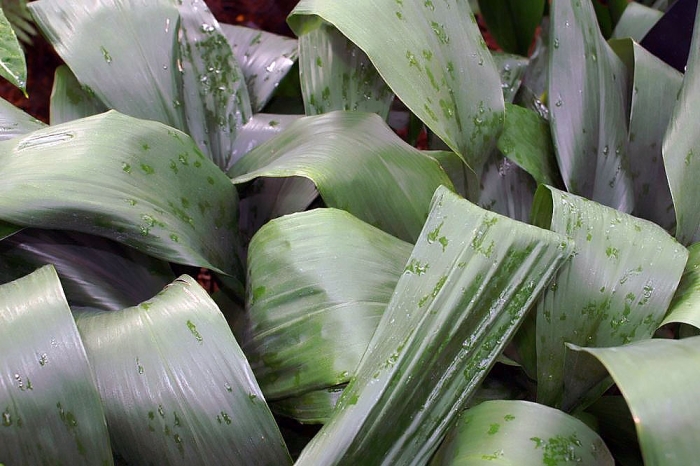Cast-Iron Plant
(Aspidistra elatior)
Cast-Iron Plant (Aspidistra elatior)
/
/

Photo by David J. Stang
CC BY-SA 4.0
Image By:
Photo by David J. Stang
Recorded By:
Copyright:
CC BY-SA 4.0
Copyright Notice:
Photo by: Photo by David J. Stang | License Type: CC BY-SA 4.0 | License URL: https://creativecommons.org/licenses/by-sa/4.0 | Uploader: David Stang | Publisher: Wikimedia Commons | Title: Aspidistra_elatior_1zz.jpg | Notes: Uploaded own work with UploadWizard |


















































Estimated Native Range
Summary
Aspidistra elatior, commonly known as Cast-Iron Plant, is an evergreen perennial herb native to the understory of forests in Japan and Taiwan, where it thrives in the stable conditions of the forest floor. It typically grows to 60 cm (24 in) tall and wide, presenting a clump-forming habit with glossy dark green leaves that are 30–50 cm (12–20 in) long. The Cast-Iron Plant produces fleshy, 8-lobed cream flowers with maroon coloring on the inner surface, which are often hidden among the leaves. These flowers appear in early summer and are not particularly showy, but they add a subtle charm to the plant’s appearance.
The Cast-Iron Plant is highly valued for its ability to withstand neglect, which is reflected in its common name. It is a popular choice for low-light areas in homes and offices, and it can also be used as an understory plant in shaded outdoor gardens in temperate climates. Its resilience extends to tolerating low humidity, temperature fluctuations, and irregular watering. While it prefers part shade or full shade, it is crucial to protect it from direct sunlight to prevent leaf bleaching. Good drainage is essential to prevent root rot. This plant is often used as a ground cover or for border planting in urban and suburban landscapes due to its ease of maintenance and tolerance of poor conditions. However, gardeners should be aware that it can be susceptible to scale insects and spider mites indoors.CC BY-SA 4.0
The Cast-Iron Plant is highly valued for its ability to withstand neglect, which is reflected in its common name. It is a popular choice for low-light areas in homes and offices, and it can also be used as an understory plant in shaded outdoor gardens in temperate climates. Its resilience extends to tolerating low humidity, temperature fluctuations, and irregular watering. While it prefers part shade or full shade, it is crucial to protect it from direct sunlight to prevent leaf bleaching. Good drainage is essential to prevent root rot. This plant is often used as a ground cover or for border planting in urban and suburban landscapes due to its ease of maintenance and tolerance of poor conditions. However, gardeners should be aware that it can be susceptible to scale insects and spider mites indoors.CC BY-SA 4.0
Plant Description
- Plant Type: Herb
- Height: 2-3 feet
- Width: 1-2 feet
- Growth Rate: Slow
- Flower Color: N/A
- Flowering Season: Summer
- Leaf Retention: Evergreen
Growth Requirements
- Sun: Part Shade, Full Shade
- Water: Medium
- Drainage: Fast, Medium, Slow
Common Uses
Border Plant, Deer Resistant, Drought Tolerant, Fire Resistant, Groundcover, Low Maintenance, Potted Plant, Salt Tolerant, Street Planting
Natural Habitat
Understory of forests in Japan and Taiwan
Other Names
Common Names: Barroomplant , Cast-Iron-Plant , Schusterpalme , Aspidistra , 엽란 , Barroom Plant , Bar-Room Plant , Iron Plant , Ba-Ran , Ha-Ran
Scientific Names: Aspidistra elatior
GBIF Accepted Name: Aspidistra elatior Blume